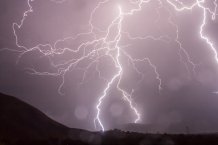articles

"When an extreme weather event is ambiguous, people are more likely to see the event through a partisan lens."
Experiencing extreme weather is not enough to convince climate change sceptics
Experiencing extreme weather is not enough to convince climate change sceptics that humans are damaging the environment, a new study shows.
Political bias and partisan news reporting influence whether people report experiencing certain extreme weather events, the research suggests.
But Americans who lived in areas where a variety of extreme events were recorded – flood, tornado, hurricane, and drought – were ultimately no more likely to share the same beliefs about climate change as scientists.
Dr Ben Lyons, from the University of Exeter, who led the research, said: “Extreme weather plays a limited long-term role in forming people’s beliefs about climate change. Instead, their views and beliefs can alter the way they perceive the weather. We have found when an extreme weather event is ambiguous, as with polar vortex and drought, people are more likely to see the event through a partisan lens. If there is grey area, people are more comfortable applying their preferred label.”
The University of Exeter, University of Michigan and University of Texas research found that Republicans were less likely to report experiencing a polar vortex, while those exposed to liberal media were more likely.
However the weather can be sometimes so extreme that it overshadows personal views - the researchers found that partisanship and media use did not affect the way people in the American Northeast – where the 2014 and 2015 polar vortex events hit hardest - reported the weather they had experienced.
Those who favoured liberal news sources such as the Huffington Post or the Daily Show reported experiencing drought more often than national weather data would suggest they actually did.
Dr Lyons said: “Very extreme weather accompanied by constant media coverage is harder for people to deny. But on the other end of the scale, droughts can take longer to have an effect, so people have some difficulty perceiving their onset and this may allow them to bring their biases to the table.”
Academics surveyed 3,057 people in the USA to ask them about the extreme weather they had experienced over a five-year period, and also if they believed in climate change, human causation, and the scientific consensus on the matter. They also asked where they lived. The experts were then able to compare these answers to official weather reports for that region for the same time period.
Data about the weather was taken from the Storm Events Database compiled by NOAA's National Weather Service (NWS). The data included droughts, floods, tornadoes, and hurricanes.
A total of 21.7 per cent of respondents reported experiencing a polar vortex, 41.0 per cent a drought, 19.8 per cent a tornado, 29.3 per cent flood, and 16.7 per cent a hurricane in the past five years. However the data shows 21.3 per cent lived in a county where a flood was recorded over the time period, 25.3 per cent a tornado, 4.3 per cent a hurricane, and 4.4 per cent drought.
A total of 59.2 per cent of respondents agreed that “there is solid evidence that the average temperature on earth has been getting warmer over the past few decades.” Of respondents who agreed with this statement, 74.2 per cent agreed that the Earth was warming mostly due to “human activity such as burning fossil fuels”.
Dr Lyons said: “This research shows people’s perception of extreme weather can be processed through partisan lenses. This means efforts to connect extreme events with climate change may do more to rally those with liberal beliefs than convince those with more conservative views that humans are having an impact on the climate.
“However, it’s important to note that we take a big-picture look rather than focus on specific events. Particularly intense events – a 100-year flood or catastrophic hurricane -- might be most capable of influencing attitudes.”
Enduring Extremes? Polar Vortex, Drought, and Climate Change Beliefs is published in the journal Environmental Communication.
Date: 2 October 2018
